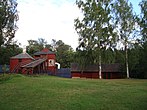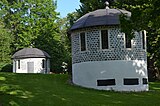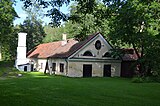Engelsberg Ironworks
| UNESCO World Heritage Site | |
|---|---|
 | |
| Location | Ängelsberg, Fagersta Municipality, Sweden |
| Criteria | Cultural: (iv) |
| Reference | 556rev |
| Inscription | 1993 (17th Session) |
| Area | 9.596 ha (23.71 acres) |
| Coordinates | 59°58′00″N 16°00′30″E / 59.96667°N 16.00833°ECoordinates: 59°58′00″N 16°00′30″E / 59.96667°N 16.00833°E |
 Location of Engelsberg Ironworks in Sweden | |
Engelsberg Ironworks (Swedish: Engelsbergs bruk) is an ironworks in Ängelsberg, a village in Fagersta Municipality in Västmanland, Sweden. It was built in 1681 by Per Larsson Gyllenhöök (1645-1706) and developed into one of the world's most modern ironworks in the period 1700–1800. It is listed as a UNESCO world heritage site since 1993.
Name[]
Engelsberg Ironworks is named after Englika. Englika, who was born in Germany, began producing iron in Engelsberg in the 14th century.[1]
History[]
The history of iron production in the region dates back to at least 13th century. The local peasants both mined the ore and produced the iron using primitive furnaces.[2]
In the end of the 16th century more modern production methods were introduced in Engelsberg and production volumes increased substantially in the following decades.[2]
Description[]
The preserved buildings include a manor house, the inspector's house and the smelting house with a blast furnace.[2]
UNESCO World Heritage Site[]
Engelsberg Ironworks is a UNESCO World Heritage Site. It was added to the list in 1993.[3] The UNESCO comments were:
Sweden's production of superior grades of iron made it a leader in this field in the 17th and 18th centuries. This site is the best-preserved and most complete example of this type of Swedish ironworks.
Gallery[]
The mansion with wings
The mansion from the garden side
The west wing
The two slag stone towers
The forge
The old office
The archives of Axel Johnson Group
The new office

The furnaces
The dam and blast-furnace
The old barn
A road at Engelsberg iron works
References[]
External links[]
| Wikimedia Commons has media related to Engelsbergs bruk. |
- World Heritage Sites in Sweden
- Museums in Västmanland County
- Industry museums in Sweden
- Cultural heritage of Sweden
- 1681 establishments in Sweden
- Sweden geography stubs
- Swedish museum stubs












